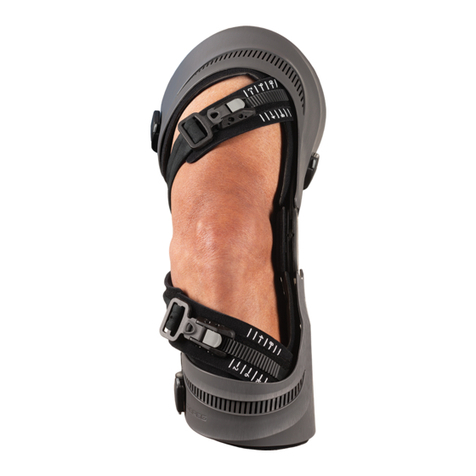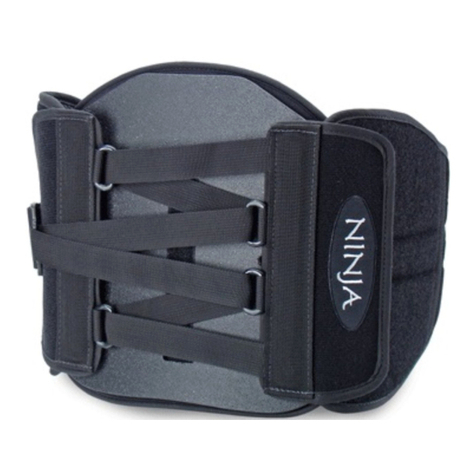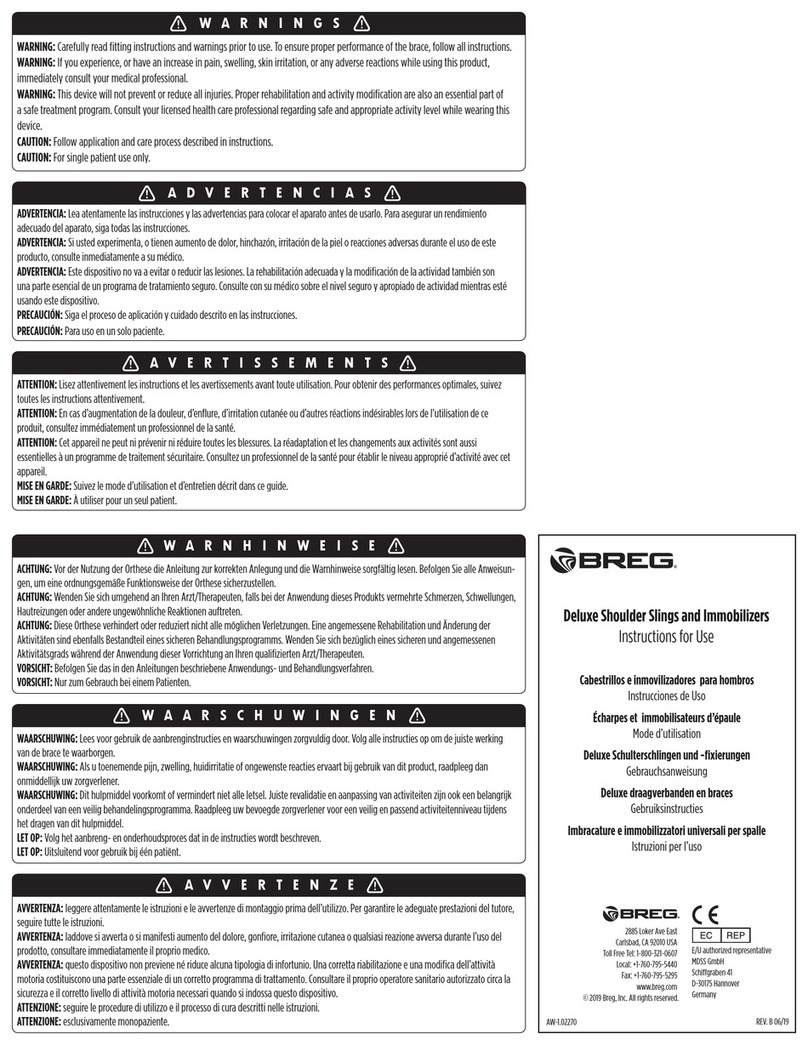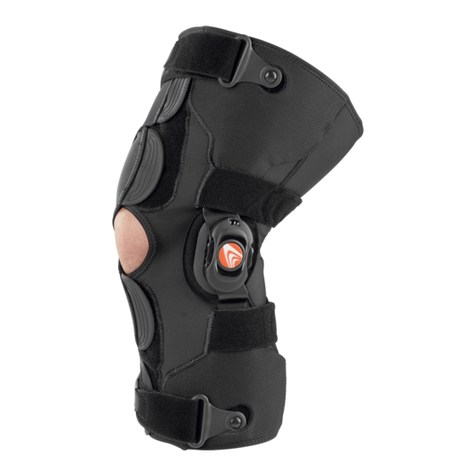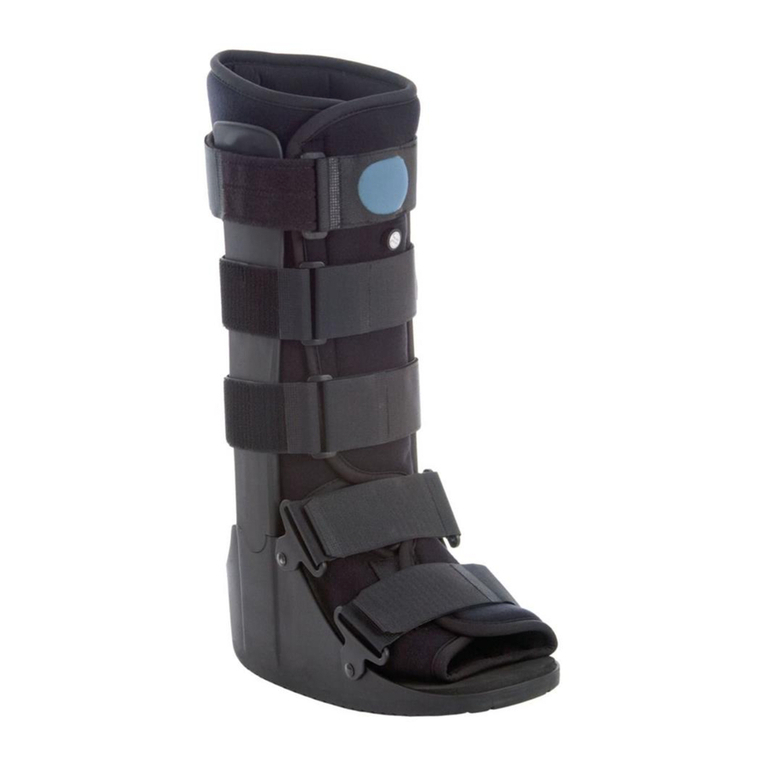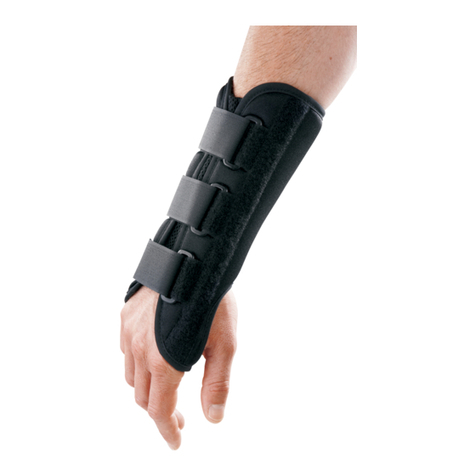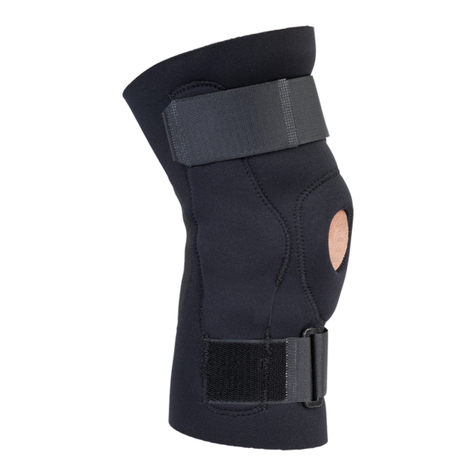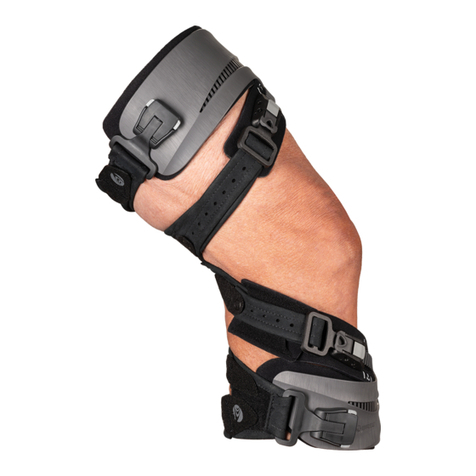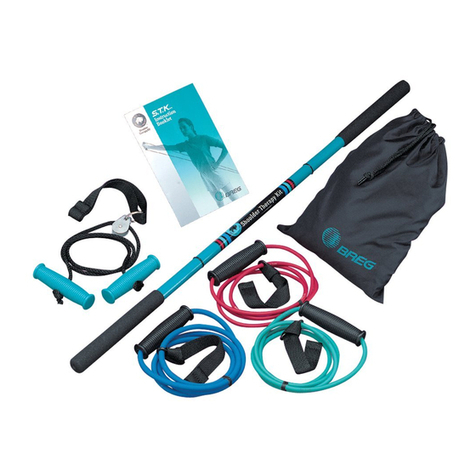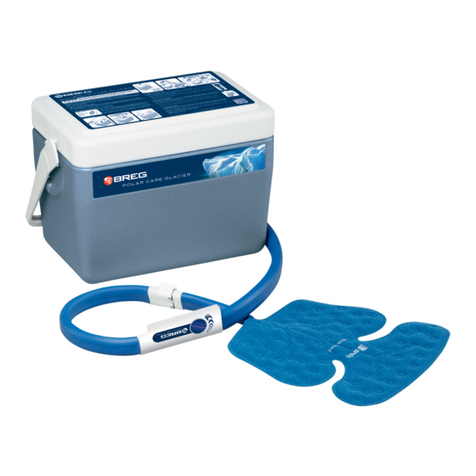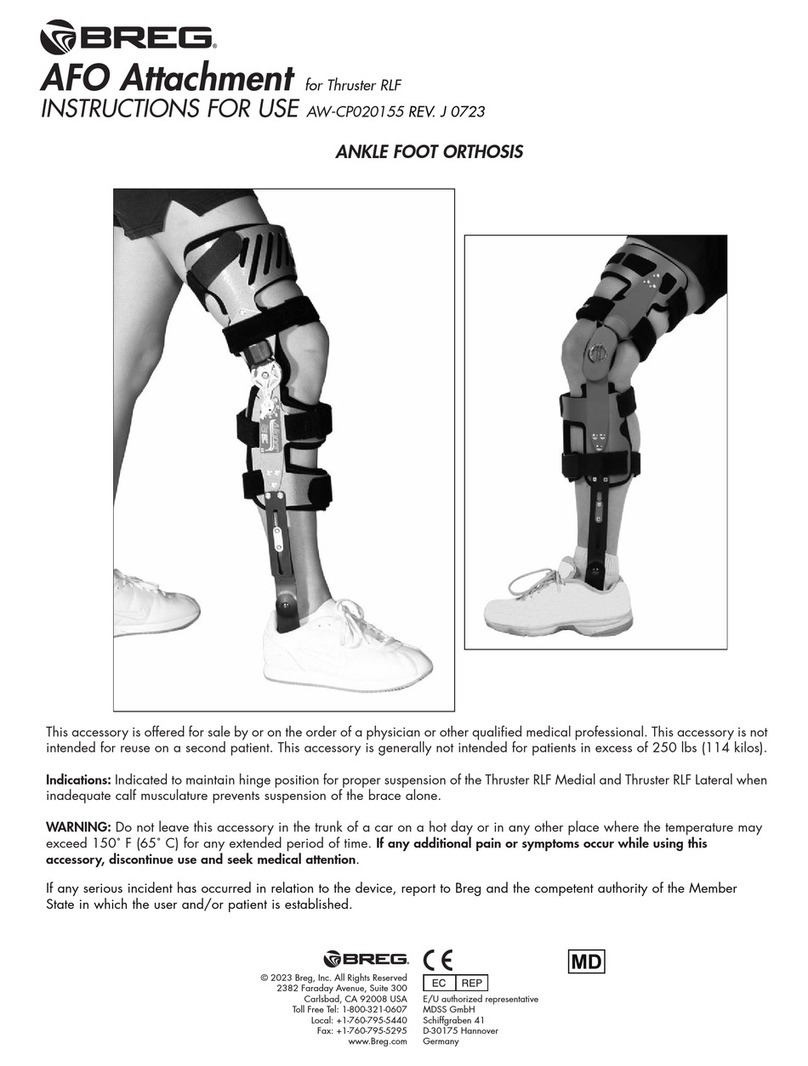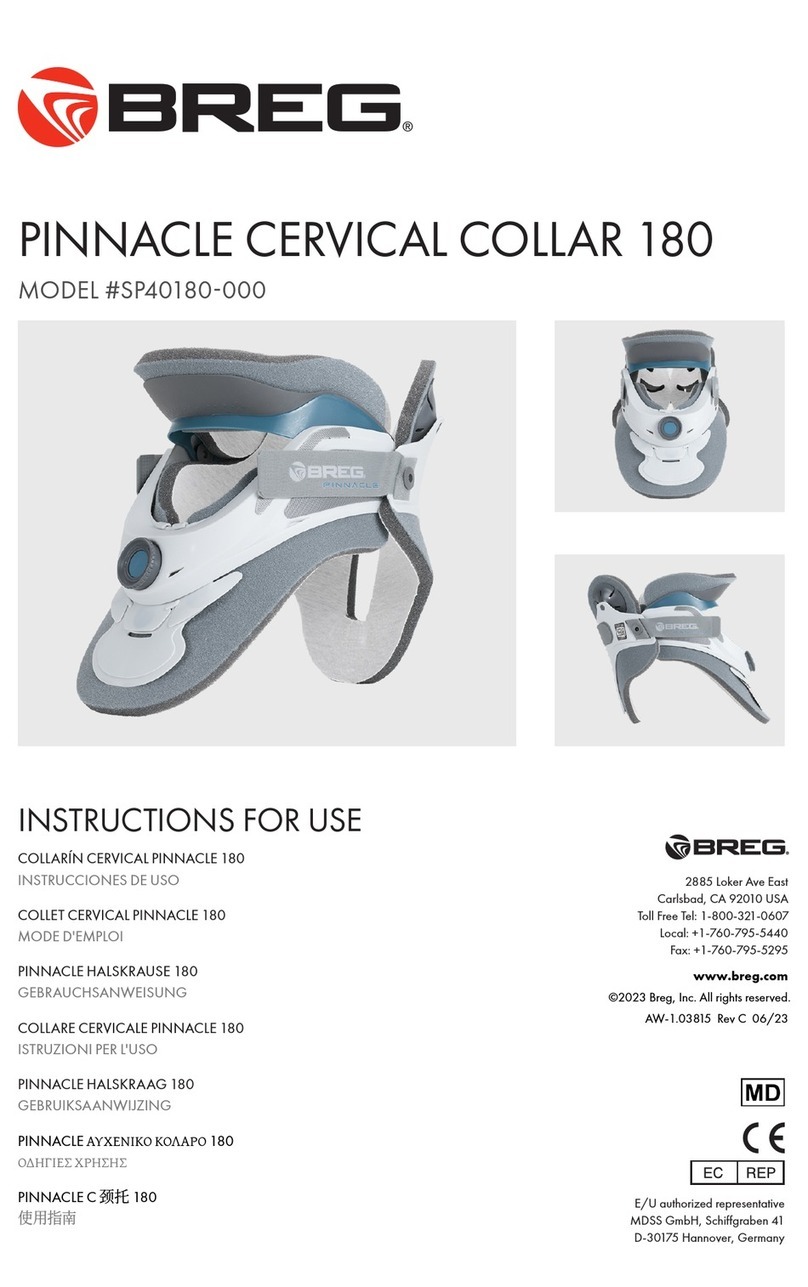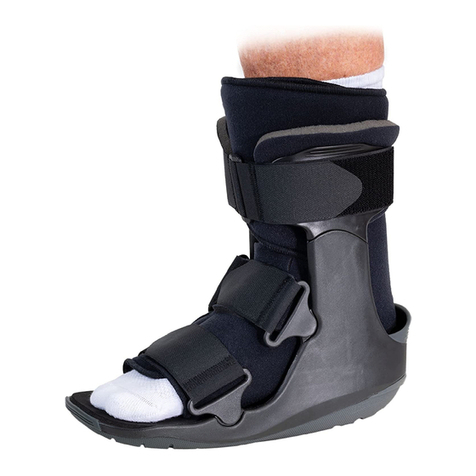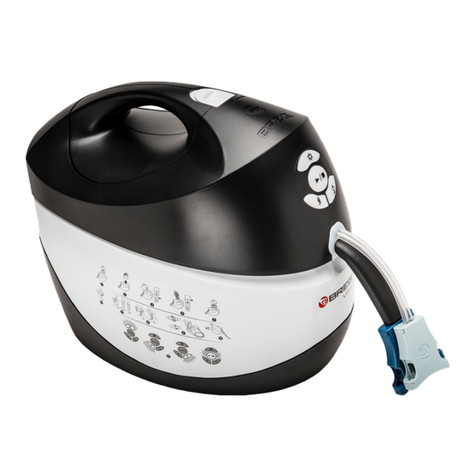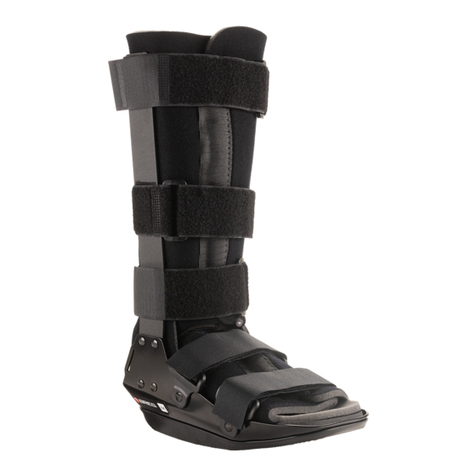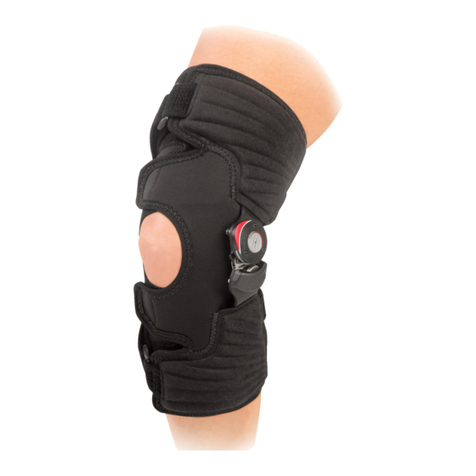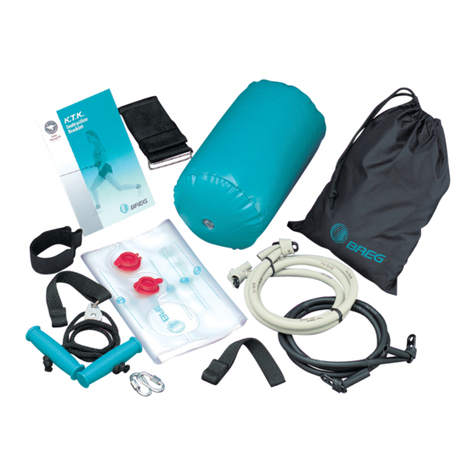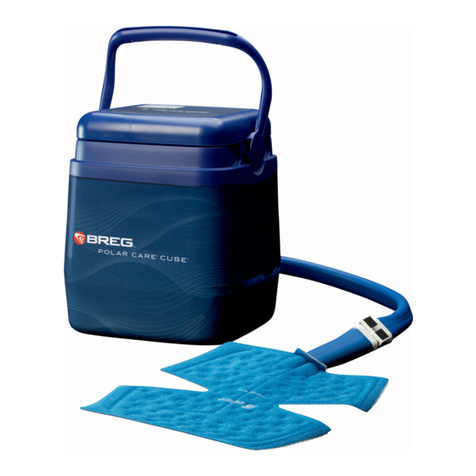
1Place foot and leg inside soft liner with heel firmly back; wearing a sock is recommended.
2Pads may be inserted to accommodate extra space at either side of ankle or at the heel. The
larger tongue pad should be positioned over the top of the foot before securing the liner.
3Close the liner snugly securing the Velcro® closures.
4Position the heel of the foot against the back of the rocker boot. Brace uprights should be
positioned midline over the ankle.
5Press the uprights securely against the liner. If there is a slight overlap, position the upright under
the overlap. (This will allow later removal of the brace without changing the position of the
upright.)
6Position the tibial straps in alternating fashion and secure all straps.
7Determine the required angle of dorsiflexion and/or plantar flexion and adjust according to the
instructions below. Note: Adjustments should be managed by the clinician directly involved with
the patient.
8Uprights may be contoured to the individual patient if required. The edge of a table or chair may
be used to aid in contouring.
FIXED ANKLE
The Pin Cam Walker is shipped from the factory in the neutral position (0°). If a fixed position other
than neutral is desired, observe the following:
1Remove the lower cap screw and rotate the cover 180°, exposing the upper cap screw. Loosen
but do not remove the upper cap screw.
2Rotate the cover to allow removal of the two pin stops. The pins may be easily pushed out from
behind.
3Note the angular markings of the disc part of the ankle joint and replace the pins in the
appropriate holes, e.g. 15-15 for 15° plantar flexion.
4Retighten the upper cap screw.
5Rotate the plastic cover until the opening faces down. Replace the lower cap screw.
FREE OR LIMITED MOTION
1Remove the upper hexsocket screw to rotate the hinge cover.
2Rotate the cover to allow removal of the two pin stops. The pins may be easily pushed out from
behind.
3Select the appropriate holes for limited motion stops and replace the pins. For free motion, the
pins are not replaced.
4Do not retighten the upper cap screw for either free or limited motion settings.
5Rotate the plastic cover until the opening faces up. Replace the hexsocket screw.
Pin Cam Application
1Den Fuß und das Bein so in die weiche Schale stellen, daß die Ferse fest hinten anliegt; das
Tragen eines Strumpfs wird empfohlen.
2Um den Platz auf beiden Knöchelseiten oder an der Ferse auszufüllen, können Polster eingelegt
werden. Das größere Zungenpolster sollte auf dem Fuß aufgelegt werden, bevor die Schale
befestigt wird.
3Schale mit dem Klettverschluß so schließen, daß sie gut anliegt.
4Da die Unterseite des Walker-Stiefels rund und kufenförmig konstruiert ist, muß die Ferse hinten
fest gegen den Stiefel gedrückt werden. Die vertikalen Stützen sollten dabei über der
Knöchelmitte angelegt werden.
5Vertikale Stützen fest gegen die Schale drücken. Sollte die vertikale Stütze über die Schale
hinausragen, muß sie so angelegt werden, daß sie unter der Überlappung liegt. (Dadurch kann die
Schiene später entfernt werden, ohne daß die Position der vertikalen Stütze geändert werden muß.)
6Schienbeingurte abwechselnd anbringen und festziehen, damit sie sicher sitzen.
7Den erforderlichen Winkel der Dorsiflexion und/oder Plantarflexion bestimmen und gemäß der
untenstehenden Anleitungen anpassen. Hinweis: Die Anpassung sollte von demjenigen Kliniker
vorgenommen werden, der direkt mit dem Patienten arbeitet.
8Falls erforderlich, können die vertikalen Stützen der Beinform des individuellen Patienten
angepaßt werden. Dazu kann eine Tisch- oder Stuhlkante verwendet werden.
FIXIERTER KNÖCHEL
Der Pin-Cam-Stiefel wird ab Werk in der neutralen Position (0°) geliefert. Wenn eine andere Position
als neutral erwünscht ist, bitte wie folgt vorgehen:
1Untere Kopfschraube entfernen und Abdeckung um 180 Grad drehen, wodurch die obere
Kopfschraube freigelegt wird. Obere Kopfschraube lockern, ohne sie jedoch zu entfernen.
2Abdeckung drehen, um die zwei Stoppstifte zu entfernen. Die Stifte können leicht von hinten
herausgeschoben werden.
3Sehen Sie sich die Winkelmarkierungen des runden Teils des Knöchelgelenks an und stecken Sie
die Stifte in die entsprechenden Löcher, z.B. 15 - 15 für eine Plantarflexion von 15 Grad.
4Obere Kopfschraube wieder anziehen.
5Plastikabdeckung drehen, bis die Öffnung nach unten zeigt. Untere Kopfschraube wieder einsetzen.
FREIE ODER EINGESCHRÄNKTE BEWEGUNG
1 Obere hexsocket Schraube entfernen, um die Gelenkabdeckung zu drehen.
2Abdeckung drehen, um die zwei Stoppstifte zu entfernen. Die Stifte können leicht von hinten
herausgeschoben werden.
3Die entsprechenden Löcher für eine eingeschränkte Bewegung wählen, und die Stifte wieder
einsetzen. Für eine freie Bewegung werden die Stifte nicht eingesetzt.
4Bei der Einstellung für die freie oder eingeschränkte Bewegung die obere Kopfschraube nicht
wieder anziehen.
5 Die Plastikabdeckung drehen, bis die Öffnung nach oben zeigt. Die Schraube wieder einschrauben.
STIFT-NOCKEN-ANWENDUNG
1Collocare il piede e la gamba all’interno della fodera morbida tenendo il tallone saldamente
all’indietro; si raccomanda di indossare una calza.
2Si possono inserire delle imbottiture per riempire lo spazio in più ai due lati della caviglia o in
corrispondenza del tallone. La linguetta più grande imbottita deve venire posizionata sopra la
parte superiore del piede prima di fissare la fodera.
3Chiudere la fodera con le chiusure di Velcro in modo che sia ben aderente.
4Posizionare il tallone contro la parte posteriore dello stivaletto amovibile. I rinforzi verticali del
supporto devono venire posizionati sulla linea mediana sopra la caviglia.
5Premere i rinforzi verticali contro la fodera. Se ci fosse una leggera sovrapposizione, collocare il
rinforzo verticale sotto la parte sovrapposta. (Questo permetterà la successiva rimozione del
supporto senza cambiare la posizione del rinforzo verticale).
6Posizionare le cinghie per la tibia alternandole e fissarle.
7Determinare l’angolo necessario di flessione dorsale e/o di flessione plantare e regolarlo
secondo le istruzioni che seguono. Nota: le regolazioni devono essere eseguite dall’operatore
sanitario che assiste direttamente il paziente.
8Se necessario i rinforzi verticali possono essere curvati secondo le esigenze di ciascun paziente.
Si può usare il bordo di un tavolo o una sedia per curvarli.
CAVIGLIA FISSA
Il deambulatore Pin Cam viene spedito dalla fabbrica in posizione neutra (0°).
Se si preferisse una posizione diversa da quella neutra, eseguire quanto segue:
1Rimuovere la vite inferiore della copertura e ruotare la copertura di 180° esponendo così la vite
superiore della copertura. Allentare tale vite superiore senza estrarla.
2Ruotare la copertura in modo da consentire l’estrazione dei due fermi del perno. I perni possono
essere facilmente estratti spingendoli dal retro.
3Notare i contrassegni angolari della parte a disco della giuntura per la caviglia e rimettere i
perni nei fori appropriati, per es.,15—15 per 15° di flessione plantare.
4Serrare di nuovo la vite superiore della copertura.
5Ruotare la copertura di plastica finché l’apertura non è rivolta verso il basso. Rimettere la vite
inferiore del coperchio.
MOVIMENTO LIBERO O LIMITATO
1 Rimuovere la vite hexsocket superiore per ruotare la copertura della cerniera.
2Ruotare la copertura in modo da consentire l’estrazione dei due fermi del perno. I perni possono
essere facilmente estratti spingendoli dal retro.
3Selezionare i fori appropriati dei fermi per il movimento limitato e rimettere i fermi. Per il
movimento libero, i fermi non vanno rimessi.
4Non fissare di nuovo la vite superiore del coperchio per le regolazioni per il movimento libero o
limitato.
5 Ruotare la copertura di plastica finché l'apertura non è rivolta verso l'alto. Rimettere a posto la
vite hexsocket.
APPLICAZIONE DI PIN CAM
WARNING: CAREFULLY READ USE/CARE INSTRUCTIONS AND WARNINGS PRIOR TO USE.
WARNING: DO NOT REMOVE WALKER BOOT UNLESS INSTRUCTED BY YOUR MEDICAL TREATMENT PROFESSIONAL.
WARNING: THIS DEVICE WILL NOT PREVENT OR REDUCE ALL INJURIES. PROPER REHABILITATION AND ACTIVITY MODIFICATION ARE
ALSO AN ESSENTIAL PART OF A SAFE TREATMENT PROGRAM.
WARNING: IF YOU EXPERIENCE INCREASED PAIN, SWELLING, OR ANY ADVERSE REACTIONS WHILE USING THIS PRODUCT, IMMEDIATELY
CONSULT YOUR MEDICAL PROFESSIONAL.
WARNING: TAKE APPROPRIATE PRECAUTIONS WHEN WALKING ON SLIPPERY SURFACES, UNEVEN TERRAIN, OR ANY OTHER PROPERTY
CONDITION WHERE THE EXERCISE OF CAUTION APPEARS NECESSARY.
WARNING: DO NOT OPERATE A MOTOR VEHICLE OR HUMAN POWERED VEHICLE WHILE WEARING THIS WALKER BOOT.
CAUTION: FOR SINGLE PATIENT USE ONLY. OUTER SOLE MAY DETERIORATE WITH MULTIPLE USES.
CAUTION: DEVICE CONTAINS LATEX—NON SKIN CONTACTING COMPONENTS.
WARNUNG: VOR GEBRAUCH BITTE SORGFÄLTIG ALLE ANLEITUNGEN ZUM GEBRAUCH UND ZUR PFLEGE SOWIE DIE WARNUNGEN LESEN.
WARNUNG: DEN WALKER-STIEFEL NICHT ENTFERNEN, AUSSER AUF ANWEISUNG DES ARZTES / QUALIFIZIERTEN PFLEGEPERSONALS.
WARNUNG: DIESES GERÄT KANN NICHT ALLE VERLETZUNGEN VERHINDERN ODER LINDERN. ANGEMESSENE REHABILITATION UND
MODIFIZIERUNG DER AKTIVITÄTEN SIND UNERLÄSSLICHER BESTANDTEIL EINES SICHEREN BEHANDLUNGSPROGRAMMS.
WARNUNG: WENN BEI DER VERWENDUNG STÄRKERE SCHMERZEN, SCHWELLUNGEN ODER ANDERE NEBENWIRKUNGEN AUFTRETEN,
KONSULTIEREN SIE BITTE SOFORT IHREN ARZT.
WARNUNG: BESONDERE VORSICHT IST BEIM GEHEN AUF RUTSCHIGEM, GLATTEM ODER UNEBENEM BODEN GEBOTEN, ODER WENN ANDERE
BEDINGUNGEN ZUTREFFEN SOLLTEN, DIE EINE ERHÖHTE VORSICHT RATSAM ERSCHEINEN LASSEN.
WARNUNG: WÄHREND DES TRAGENS DES WALKER-STIEFELS KEIN KRAFTFAHRZEUG ODER EIN DURCH MENSCHENKRAFT ANGETRIEBENES
FAHRZEUG BETREIBEN.
ACHTUNG: NUR FÜR EINEN EINZELNEN PATIENTEN VERWENDEN. DIE DECKSOHLE KANN SICH NACH MEHRFACHEM TRAGEN ABNUTZEN.
ACHTUNG: PRODUKT ENTHÄLT LATEX – DIESE TEILE KOMMEN NICHT MIT DER HAUT IN BERÜHRUNG.
AVVERTENZA:PRIMA DI UTILIZZARE IL DISPOSITIVO, LEGGERE ATTENTAMENTE LE ISTRUZIONI E LE AVVERTENZE RELATIVE ALL'USO E
ALLA MANUTENZIONE.
AVVERTENZA:NON TOGLIERSI LO STIVALETTO PER DEAMBULAZIONE SE NON DIETRO ORDINE DELL'OPERATORE SANITARIO.
AVVERTENZA:QUESTO DISPOSITIVO NON PREVIENE NÉ RIDUCE ALCUNA LESIONE. PARTE ESSENZIALE DI UN PROGRAMMA TERAPEUTICO
COMPLETO SONO ANCHE UNA RIABILITAZIONE ADEGUATA E LA MODIFICA DELLE ATTIVITÀ SVOLTE.
AVVERTENZA: SE DURANTE L'USO SI ACCUSANO UN AUMENTO DI DOLORE, GONFIORE O QUALUNQUE ALTRA REAZIONE AVVERSA,
CONSULTARE IMMEDIATAMENTE IL PROPRIO OPERATORE SANITARIO.
AVVERTENZA: ADOTTARE PRECAUZIONI ADEGUATE QUANDO SI CAMMINA SU SUPERFICI SCIVOLOSE, TERRENO ACCIDENTATO O SE LE
CONDIZIONI DEL PERCORSO SONO TALI DA RICHIEDERE PARTICOLARE ATTENZIONE.
AVVERTENZA: NON GUIDARE AUTOMOBILI O ALTRI VEICOLI CHE NECESSITANO DEL COMANDO DI UNA PERSONA QUANDO SI PORTA
QUESTO STIVALETTO PER DEAMBULAZIONE.
ATTENZIONE: ESCLUSIVAMENTE PER UN SINGOLO PAZIENTE. LA SUOLA ESTERNA POTREBBE DETERIORARSI SE USATA RIPETUTAMENTE.
ATTENZIONE: IL DISPOSITIVO CONTIENE COMPONENTI IN LATTICE CHE NON VENGONO A CONTATTO CON LA PELLE.


